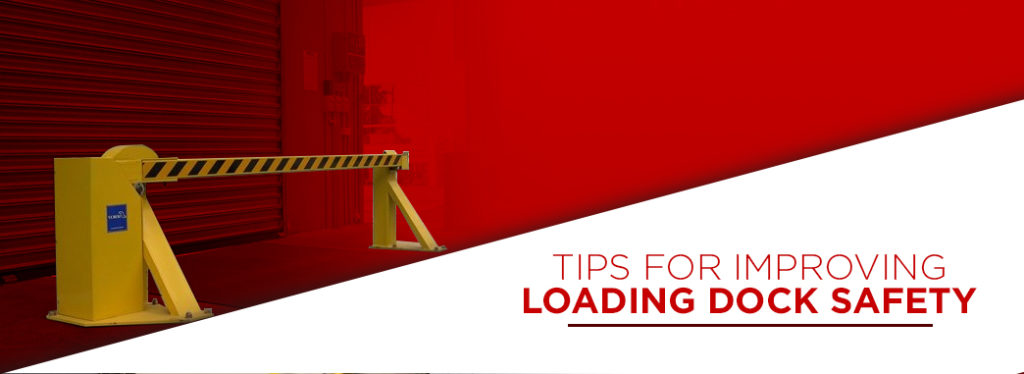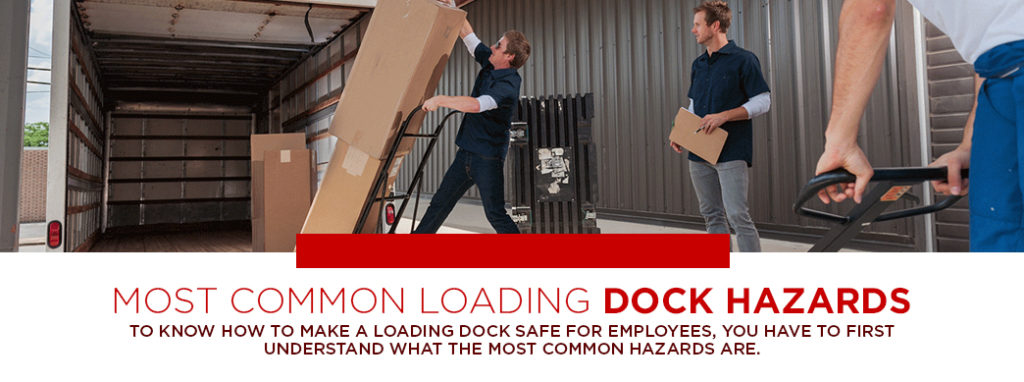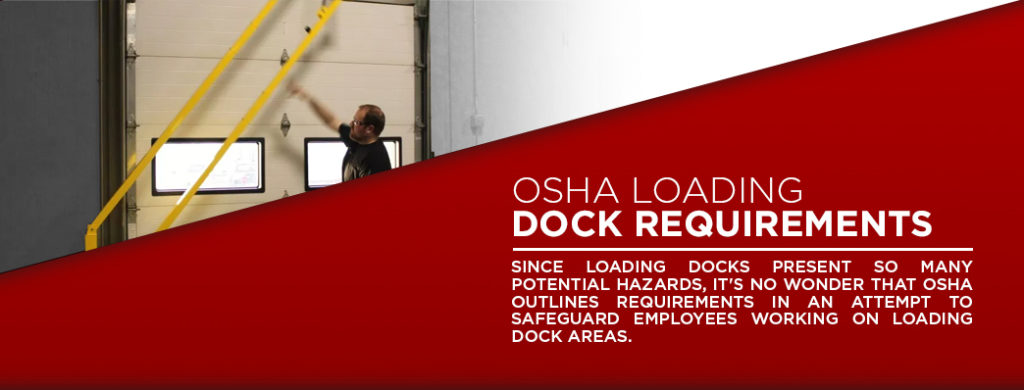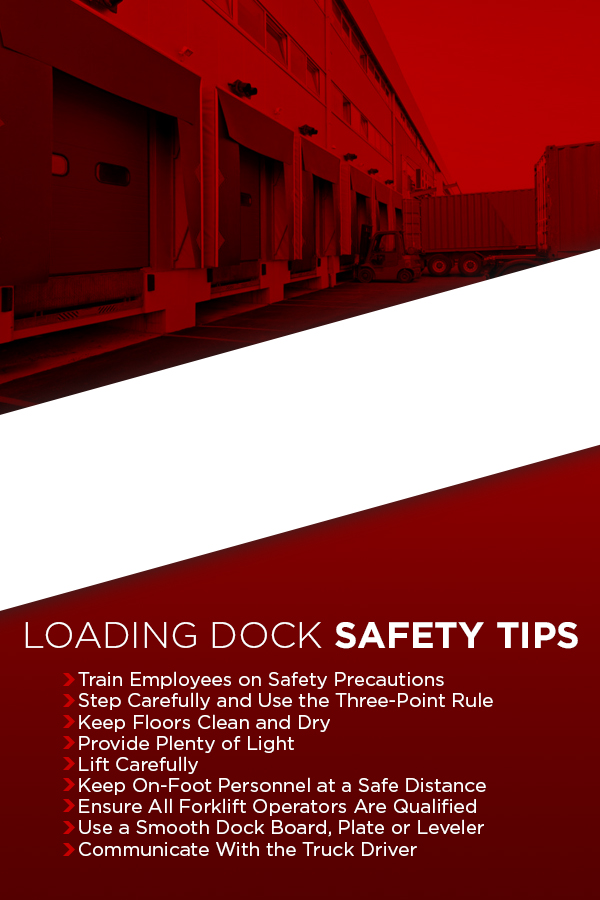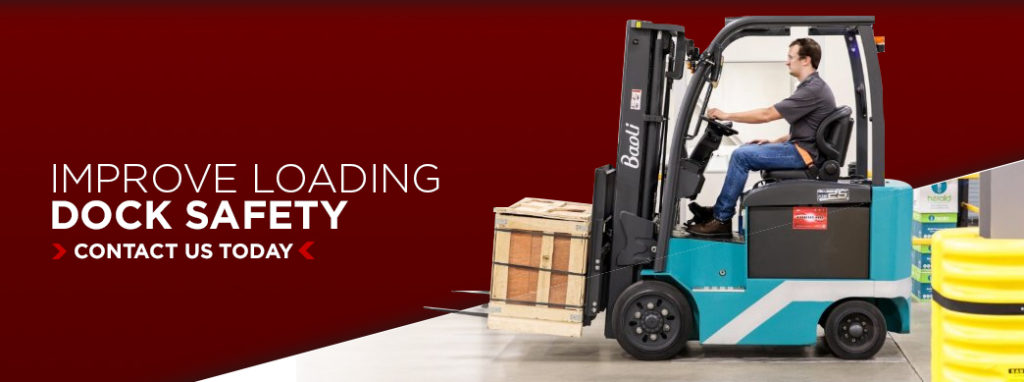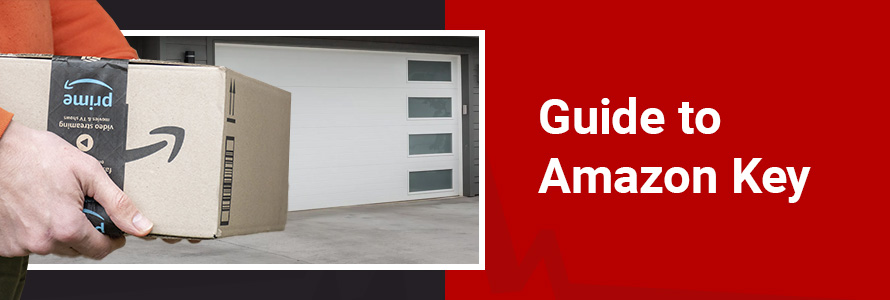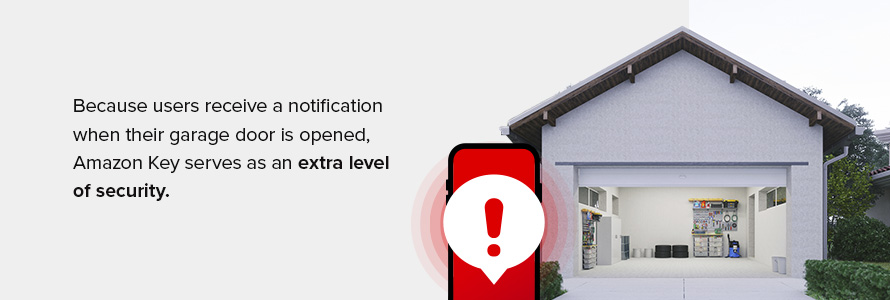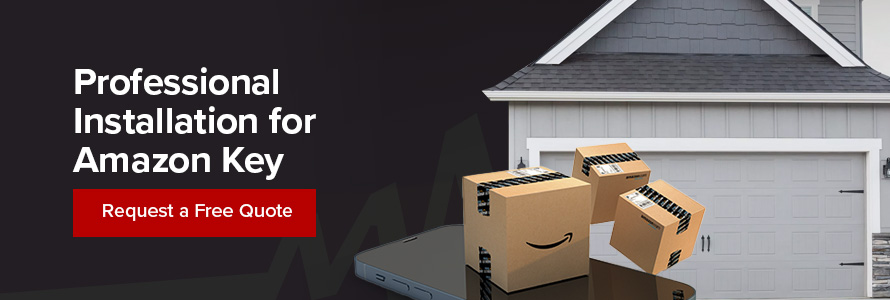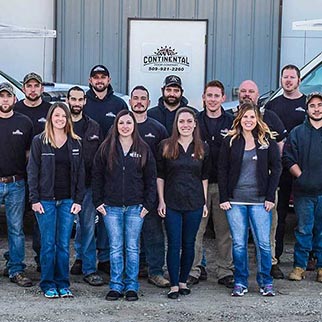Tips for Improving Loading Dock Safety
A loading dock, also sometimes called a loading bay, is the area of a commercial or industrial facility where goods are loaded onto or unloaded from a vehicle, often a semi-truck. Loading docks are typically attached to a storage room, staging area or freight elevator. Though all loading docks serve the same purpose, they don’t all look the same. The most common type of loading dock is an opening that is flush with the building’s exterior. A truck can back all the way up to the opening, and freight can be loaded and unloaded without exposure to the elements.
One thing all loading docks have in common is that, while they’re essential to loading and unloading operations, they can be one of the most dangerous areas of the facility for warehouse workers. Loading docks are home to approximately a quarter of all reported warehouse injuries. The good news is that the majority of accidents that take place on a loading dock are preventable. With the right safety equipment and protocols, your business can make loading docks a safer place to get the job done.
Table of Contents
- Most Common Loading Dock Hazards
- OSHA Loading Dock Requirements
- Loading Dock Safety Tips
- Improve Loading Dock Safety
Most Common Loading Dock Hazards
To know how to make a loading dock safe for employees, you have to first understand what the most common hazards are. The Occupational Safety & Health Administration (OSHA) highlights two major hazards. Since a loading dock is elevated to meet the height of a semitrailer, falling off the edge of the dock is one serious risk. The other is skidding or slipping when the surface of the dock becomes slick from rain or ice.
These are both major risks, but they aren’t the only potential perils of loading docks. Here are several other dangers to be aware of:
- Trailer Separation: This problem is common enough that it goes by several nicknames: trailer walk, dock walk and — most commonly — trailer creep. The weight of forklifts entering and exiting the trailer can cause it to gradually drift away from the dock until there is a dangerous gap between the trailer and the dock.
- Premature Departure: If a miscommunication occurs and a truck driver mistakenly pulls away from the dock prematurely, it could cause a forklift driver entering, exiting or inside of the trailer to be injured.
- Landing Gear Collapse: Damaged or weak landing gear on a trailer can suddenly fail, allowing the trailer to move. It could either pitch forward or swing off to one side. This can injure employees who are entering, exiting or inside of the trailer.
- Trailer Pop-Up and Up-Ending: Pop-up can occur when the weight of a loaded forklift entering the back end of the trailer causes the trailer to press down in the back and pop up in the front. Up-ending is the opposite, but equally dangerous, problem, where the trailer’s nose is forced down, causing the back to rise.
- Dock Shock: Dock shock refers to the health and safety hazard that lift truck operators experience when they are jarred by a bumpy transition crossing over from the warehouse floor to the loading dock.
- Unsecured Loads: When a load on a forklift or other powered truck isn’t properly secured, it can slide off, causing injury to the forklift driver or any other employees within close proximity.
- Lifting: Though not unique to loading docks, lifting equipment is also a common source of warehouse injuries and often occurs when employees are loading and unloading goods at the loading dock. Though a back strain may seem less serious than a fall or other injury, a first-time back injury can cost $10,000 and can put an employee out of commission for some time.
OSHA Loading Dock Requirements
Since loading docks present so many potential hazards, it’s no wonder that OSHA outlines requirements in an attempt to safeguard employees working on loading dock areas. Depending on your industry, the types of equipment you use and specific hazards related to your operations, there will be many OSHA standards you should pay attention to. Let’s look briefly at three different standards that are relevant to any loading dock. Note that OSHA standards are a federal baseline. Your state may have its own more stringent requirements to pay attention to.
Guard Rails
When your dock door is open, a worker could potentially fall from the platform. OSHA standard 29 CFR 1910.23 outlines the requirement for guard rails on dock door openings when they’re open. This standard requires any wall opening that is four or more feet up from the ground to be guarded by a barrier consisting of a top rail, intermediate rail and posts. The guard rail should be about 42 inches from the floor, so it effectively stops someone from falling.
Forklifts
OSHA standard 29 CFR 1910.178 covers the use of powered industrial trucks, more commonly referred to as lift trucks or forklifts. An overturned or fallen forklift can crush people, causing serious injury or even fatalities, so there are many requirements for these vehicles. Some of the most basic requirements are that these pieces of equipment must meet the American National Standard for Powered Industrial Trucks, Part II, ANSI B56.1-1969 and must be operated only by trained workers.
Another relevant requirement for loading docks is that railroad cars or highway trucks or trailers that are being boarded by powered industrial trucks for loading and unloading purposes must have their breaks set and be secured by wheel stops or other effective protection, so they don’t move. If a semitrailer is not attached to a tractor, then it may need to be supported by fixed jacks. OSHA also requires that workers check to make sure the floor inside a trailer is in good shape before driving into it.
Personal Protective Equipment
Standard 29 CFR 1910.132 discusses the use of personal protective equipment (PPE) in the workplace. This information has fairly broad applications, including on the loading dock. The standard states that, wherever it is necessary, the proper PPE must be provided. This leaves it up to businesses to carefully determine what types of PPE their employees might need. However, based on the OSHA standard, the following are typically recommended for loading dock workers:
- Safety boots
- High-visibility clothing
- Gloves
- Hearing protection
- Eye protection
View Loading Dock Equipment Products
Loading Dock Safety Tips
Now that we’ve looked at the hazards present on a loading dock and at the relevant OSHA requirements to take into account, let’s look at 10 tips to help you adopt effective loading dock safety precautions that will keep all workers safe. Make sure you evaluate your own facility and operations to see if there are other ways you can help prevent problems with loading and unloading.
1. Train Employees on Safety Precautions
Any time you look at improving loading dock safety, you need to get any employees who work on loading and unloading or who work within the vicinity of the loading dock on board. Provide training to any new workers and periodically to experienced workers to remind them of important safety protocols such as inspecting palletized product to make sure it is secure before moving it or properly communicating with other workers to keep the loading dock safe for everyone.
2. Step Carefully and Use the Three-Point Rule
Emphasize to employees that they can help prevent falls by stepping carefully on the loading dock. Workers should never run and should be careful to remain a safe distance from the dock edges. They should never jump off the dock as this can cause trauma to the back, knees and ankles. When stepping on or off of a piece of heavy equipment, remember the three-point contact rule. This rule says that operators should keep three limbs on the vehicle when stepping in or off.
3. Keep Floors Clean and Dry
Another way to help prevent slips and falls is by keeping the floor dry and clear of any objects or debris. Containers, tools and any other materials should stay out of the way of loading and unloading operations. Schedule regular cleanings to make sure the loading dock area remains tidy. If spills occur or if rain, snow or ice leaves the floor wet, mop the floor immediately and allow it to dry.
4. Provide Plenty of Light
When an area is dark, it increases the chance that employees won’t see spills or small objects like nails that could cause an injury. It can also make it easier for collisions to occur. Make sure the dock area is well-lit and that lift trucks are equipped with spotlights so drivers can see everything in front of them, whether on the warehouse floor or in a semitrailer.
5. Lift Carefully
To prevent injuries from lifting heavy materials, make sure all employees follow best practices for lifting. This includes never lifting skids and pallets on their own and, when they are lifting materials, bending their knees with their back straight so as not to strain their back. They should also wear work gloves to help them get a firm grip on whatever they’re lifting.
6. Keep On-Foot Personnel at a Safe Distance
Because workers can be hit by heavy machinery and seriously injured or killed, workers on foot should make sure they maintain a safe distance from heavy equipment. This especially means making sure you are never in a trailer when a forklift is entering or exiting. To help enforce this precautionary measure, try marking the floor with highly-visible tape or paint to indicate where it is safe to walk.
7. Ensure All Forklift Operators Are Qualified
OSHA requires that all powered industrial truck operators are trained for a reason. If an employee is unauthorized to operate heavy machinery but thinks they can operate a forklift in a pinch, this could lead to potential injuries and lawsuits. Make sure employees you intend to operate forklifts or other heavy equipment have gone through the training they need for that particular piece of machinery, and make sure unauthorized workers understand they are never allowed to operate a forklift if they haven’t been trained to do so.
8. Use a Smooth Dock Board, Plate or Leveler
Dock boards, plates and levelers provide a connection between the loading dock and the inside of the semitrailer. Dock boards and plates provide a straight transition while dock levelers help to make up for differences in height between the loading dock floor and the trailer. Whatever you’re using to make the transition, make sure it provides a smooth path. The smoother the transition, the less chance lift truck operators have of experiencing dock shock. Make sure these transition pieces are correctly positioned and secure before anyone drives over them.
9. Communicate With the Truck Driver
Since a miscommunication with a driver could cause a serious injury, make sure the driver is aware of what’s going on at all times. Whether you use colored lights, hands signals or some other system, make sure the driver has a visual at all times that they can see in the truck mirrors. Drivers should always do their due diligence to make sure the trailer is clear before pulling away from the loading bay. Some drivers may hand their keys off to someone else who can return them once loading or unloading operations are complete.
10. Use Vehicle Restraints
Trucks should always be secured with vehicle restraints, so they aren’t able to roll away from the loading dock. Wheel chocks are a traditional way of doing this, but modernized rear impact guard (RIG) locking devices can do even more. As the name suggests, these locking devices attach to the truck’s RIG using a full rotating hook. These devices can prevent the hazardous issue of trailer separation. For added protection, look for a model that includes a communication system, so you always know when they’re engaged. Some may even issue an audible alarm when necessary.
Improve Loading Dock Safety
Loading docks may be known as notoriously dangerous areas, but they don’t have to be. A major step toward keeping your loading dock safe is committing, along with your employees, to observing safety precautions at every turn. Think of the OSHA standards only as a starting point. Follow the tips in this article and look for other ways you can make your environment safer.
Another critical step toward a safer loading dock is having the right safety equipment. The right vehicle restraints, levelers and more can make all the difference in preventing injuries and other problems.
Since 2000, Continental Door, Co. has serviced the communities in Spokane, Spokane Valley, Coeur d’Alene and the surrounding areas in Washington, Northern Idaho, Northeastern Oregon and Eastern Montana. In addition to providing and installing residential and commercial garage doors, we carry quality equipment for loading docks. We understand just how crucial the right equipment is to helping you get the job done safely day after day. Contact us today with any questions or comments or to learn more about how you can make your loading dock a safer place to work.
Request More Information About Loading Dock Equipment Products
Updated: 05/22/2019
Guide to Amazon Key
Guide to Amazon Key
As the world evolves, technology becomes a more significant part of our everyday lives. One of the biggest technological trends today is online shopping. Purchasing an item that may not be in your local store and having it delivered appeals to consumers.
Amazon is one of the most popular online retailers. In 2022, Amazon’s revenue was almost $514 billion, and there were 168 million Amazon Prime users in the U.S. in the same year. Since there are millions of Prime subscribers, Amazon frequently updates the benefits so the membership remains enticing.
A relatively new benefit for Prime members is Amazon Key In-Garage Delivery. This service allows couriers to deliver packages to your garage.
What Is Amazon Key and How Does It Work?
Amazon Key In-Garage Delivery aims to provide a secure transit between sellers and buyers. Although granting strangers access to your garage may raise privacy concerns, Key’s main benefit is protecting your property. Simply put, Amazon hopes to help you reduce your risk of package theft or other property damage by asking you to give their delivery team authorization to enter your garage.
In 2022, 49 million Americans were victims of package theft. Despite a penalty that includes fines and up to five years in prison, package theft continues to be a major problem for consumers. Considering this, online retailers are eager to find more secure methods of ensuring an item reaches its intended target. By granting entrance to your garage, you ensure your packages are delivered to a secure location.
While delivery security is the primary push for Key, Amazon also touts the everyday utility of the service. Because users receive a notification when their garage door is opened, Amazon Key serves as an extra level of security. It can let parents know when their children come home and alert homeowners of unwanted guests. Additionally, it can even provide peace of mind on busy mornings, quickly putting to rest the worry of whether you’ve forgotten to close the garage door.
How Does Key Work?
The service itself is simple. First, customers link their myQ garage to Key in the Amazon shopping app. At checkout, you choose “free Key delivery” instead of “doorstep delivery.” You’ll receive shipping and delivery updates on your item. When the driver arrives with your package, they scan it so a company representative can verify the time and other confirmation details and grant them temporary access to your garage.
Once the delivery is complete, the same employee will remotely close the entrance. After the employee delivers the package and locks the garage, you will receive a confirmation message that the process is complete.
What Are the Installation Requirements for Amazon Key?
While the service is simple, a few requirements exist for setting up Amazon Key In-Garage Delivery. If you already have some of the starting pieces — such as an Amazon Prime account or a Wi-Fi-compatible door opener — the installation process will be easier. Moreover, professionals may be able to assist in guiding you through the selection process, ensuring you get the appropriate materials for your needs.
Here is a basic rundown of the tools you’ll need to operate Amazon Key:
- Prime membership: First, to be eligible for delivery services, you will need an Amazon Prime membership, which costs $139 per year. Prime membership is Amazon’s customer service bundle, which includes free two-day shipping on most items, access to video and music streaming and perks for Alexa smart speakers.
- MyQ–compatible garage door opener or hub: If you do not currently have a garage door opener with Wi-Fi capabilities, you’ll need to upgrade it. Be sure your equipment is myQ compatible so that you’ll have no issues using the Amazon app.
- Amazon Key App: As always, there’s an app for that. The free Amazon Key app is your remote access point. It’s available for both Android and iOS, though only in U.S. app stores. You can also access In-Garage Delivery through the Amazon Shopping app.
- Ring app: You can use the Ring app to add a compatible camera, such as the Ring Indoor Cam and the Ring Stick Up Cam, to watch your deliveries in real time. You do not need a camera for In-Garage Delivery services.
- Professional Installation: Continental Door can upgrade your garage door opener to ensure myQ compatibility and set up Amazon Key.
Amazon Key FAQ
While there are clear positives to using Amazon Key, new technology always brings its share of concerns. Here are some of the most frequently asked questions about Amazon Key In-Garage Delivery:
1. Is Amazon Key Only for Prime Members?
Amazon Key is only available to those with an Amazon Fresh, Amazon Prime, Amazon Household and Prime Student subscription or a free trial of these subscriptions. You also need to be in an eligible location for In-Garage Delivery.
2. Is Amazon In-Garage Delivery Safe?
People view the home as a safe place. For those with a garage that is not a part of the house or those with a locked exterior door separating the two, In-Garage Delivery may be fine. However, if your home is easily accessible through the garage, you’ll want to take extra precautions to safeguard your entrance.
Aside from the physical danger of an intruder, it’s reasonable to consider what a delivery person might do once they have access to your garage. If your garage contains expensive hobby equipment, motorcycles or valuable items, granting permission for a stranger to enter while you’re not home may feel like an invitation for trouble.
Amazon runs comprehensive background checks on the drivers before their first delivery. They verify the driver, location and package before granting them access to your garage. The drivers can only go 5 feet into your garage when delivering the package.
You can use a security camera in conjunction with Key to monitor the delivery. A security camera gives you evidence if you discover something amiss. And, if you change your mind about in-garage delivery before the delivery day, you can block access to your garage and switch to doorstep delivery.
3. Can I Store Camera Footage?
The compatible Ring cameras allow you to record your videos if you have a Ring Protect Plan. Without the Ring Protect Plan, you can access Live View to monitor the delivery.
4. What if My Garage Won’t Close?
Drivers must leave your garage as they found it. So, if your garage was closed, they must close it before they can leave. Similarly, if you leave your garage door open, the delivery driver will not close it before leaving. If you leave your door closed, but the driver cannot close it after delivering your package, customer support will contact you and have a technician come and close your door.
Professional Installation for Amazon Key
Packages disappear off customers’ doorsteps daily. To prevent this, many people utilize Amazon Key. With the right setup and equipment, you can enjoy increased security and comfort when you’re expecting your next delivery. Continental Door can install and maintain your myQ System for Amazon Key. For over 15 years, we have provided high-quality services, including 24/7 emergency repair service, and products to our customers in the greater Spokane and Coeur d’Alene areas. Contact us today for a free quote to set up Amazon Key.
Updated: 05/22/2019

